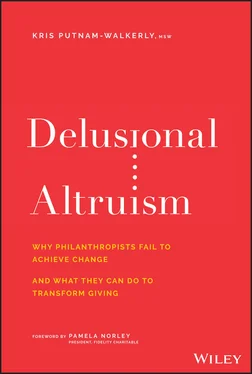4 You hold a belief that every dollar you raise should go to the people and communities in need. You feel guilty investing in yourself.
5 You believe the real problems you want to tackle are impossible to solve with your funding. Instead of figuring out how to leverage your funding for outsized impact, you choose smaller, easier-to-solve problems. You often fund projects that eradicate the symptoms and not the cause.
6 You know something is critical to the success of your endeavor (e.g., a communications plan, developing partnerships, taking time off), but you never feel you have the time or resources to obtain it, do it, or fund it.
7 You don't invest in the people who could help you navigate your philanthropic journey, avoid mistakes, or save time. These could be trusted advisors, professional services (e.g., attorneys, accountants, donor-advised fund sponsors), content experts, consultants, or administrative support professionals.
8 You or your staff feel you don't have time to regularly think, plan, or build relationships because you're always too busy.
How did you do?
Let's first look at the worst-case scenario. If you scored 6–8, you need an intervention. You might even need therapy! In all seriousness, with a score like that, I'd wager that a scarcity mind-set is holding your philanthropy hostage. You could have greater impact, but you thwart yourself at every turn. But don't panic. Remember, a scarcity mind-set is just that—a mind-set. It's your beliefs. Beliefs can be changed. And just as in Alcoholics Anonymous, the first step is to admit you have a problem.
If you scored 3–5, your scarcity mind-set is certainly holding you back, but it's not strangling you. At least, not yet. Take a good look at the statements to which you answered “no.” If you embrace an abundance mind-set for those questions, think about how you can transfer that abundance mind-set to all aspects of your giving. (I will tell you more about an abundance mind-set in Chapter 9, “You See and Act Abundantly”).
If you answered “yes” to only one or two statements, you are in pretty good shape. But take a hard look at those statements. What's holding you back? Why do you feel scarcity in those areas? What investments in time or resources could unleash your effectiveness?
Now, if you scored a zero, you're likely in denial! Reread this chapter and open yourself up to the possibility that you are holding yourself back in some area of your work or life. In my entire professional career, I can only think of one person who genuinely, consistently, and in all aspects of his life could answer “no” to all of these questions.
Now, if you do truly feel that none of this applies to you, email me at kris@putnam-consulting.comand let me know how you do it! Seriously, I'd love to hear from you.
What causes a scarcity mind-set? In my experience advising hundreds of wealthy donors, corporate executives, foundation leaders, and everyday givers, it comes down to just one thing: fear. Funders feel fear, and this fear causes them to hold back.
In the next chapter, we'll take a close look at how fear contributes to a scarcity mind-set and the different kinds of fear that cause funders to hold back. Once you face your fears, you can overcome them.
1 1. Author interview with Lisa McLeod, August 8, 2019.
2 2. https://www.alliancemagazine.org/feature/financial-and-non-financial-striking-a-balance/.
3 3. https://www.alliancemagazine.org/feature/five-lessons-about-human-capital/.
4 4. “The Real Cost Project: Increasing the Impact of Philanthropy in California,” August 2016, https://www.socalgrantmakers.org/sites/default/files/files/pages/Real%20Cost%20PRoject%20Final%20Report%20Full%20Version%20FINAL.pdf.
5 5. http://s5770.pcdn.co/wp-content/uploads/2014/10/GS_OverheadMyth_Ltr_ONLINE.pdf.
6 6. https://nff.org/news/nff-survey-nonprofits-are-challenged-creative-unwavering.
7 7. https://www.alliancemagazine.org/blog/debunking-two-myths-avoid-agony-italian-civil-society/.
8 8. https://philanthropyinfocus.org/2018/11/26/a-look-inside-central-asian-philanthropy/.
I recently spoke to the CEO of a foundation association who wanted to refresh the association's strategic plan. He wanted to start with a “learning tour,” on which staff and board members would travel to multiple cities, set up town hall meetings in each, invite funders to attend, and engage in an orchestrated conversation to “learn” in order to inform the strategic plan. I told him he suffered from a scarcity mentality and was wasting time and resources. As you can imagine, he was shocked.
I explained that between his many talented staff, his seasoned board members who represented their entire geographic footprint, research they recently commissioned, and his team's collective learning from attending conferences and talking with members, they already knew 80% of what they needed to know. There were much faster and cheaper ways to gain that missing 20% than spending six months on a “learning tour.”
The leadership of this organization suffered from a scarcity mentality because of fear. They didn't trust their own talent. They lacked confidence that they already had most of the knowledge they needed, or that they could quickly gain the rest. They didn't regularly invest time in their own organizational learning to capture and use this knowledge. As a result, they were willing to spend a lot of time and money on the wrong things (the learning tour)—and were willing to hurt themselves by postponing strategy development as a result. They were delusional in their altruism. They thought they were doing the right thing, but they were just getting in their own way.
Fear manifests itself in myriad ways in philanthropy. And it causes loads of problems. Fear wastes money, time, and talent. It prevents you from learning and improving. It results in less impact. And it's no fun! Who wants to be fearful?
Let's talk about some of the most common ways we experience fear in philanthropy. As you read these examples, think about the many ways fear holds funders back and how this contributes to a scarcity mentality. It might result in funders giving less, investing less in their own growth and development, or not openly sharing what they are doing and learning.
Fear of “Coming Out” in Support of a Cause
Many funders fear taking a stand on an issue. They worry that there could be negative repercussions to their reputation. They worry people might no longer fund them, hire them, or like them. This happens frequently with community foundations.
Community foundations are grantmaking public charities that raise money from donors in their community and make grants to nonprofits in that same community. Because they serve the entire community, they often feel compelled to meet everyone's needs. For example, they feel they need to support all issues—from healthcare to the arts to education—and appeal to all donors. As a result, they fear that if they take a leadership role on a particular issue, such as racial equity or education reform, they might alienate some of those donors.
Similarly, celebrities fear “coming out” in support of specific causes because it might alienate fans, cause a backlash, and result in fewer starring roles. In today's polarized world, electrified by social media, this fear is not unwarranted. Actor Tom Selleck learned this when he posed for a print advertisement for the National Rifle Association (NRA). The ad depicted him with a rifle over his shoulder accompanied by the slogan “Shooting teaches young people good things.” It came out a month following the 1999 massacre at Columbine High School in Colorado, where two high school students murdered 13 people and injured 21 students. 1 The unfortunate timing of the ad resulted in a public backlash, starting with a challenging televised appearance on The Rosie O'Donnell Show where, instead of plugging his new film The Love Letter as he had planned, Selleck ended up debating gun control with host O'Donnell for more than seven minutes.
Читать дальше












